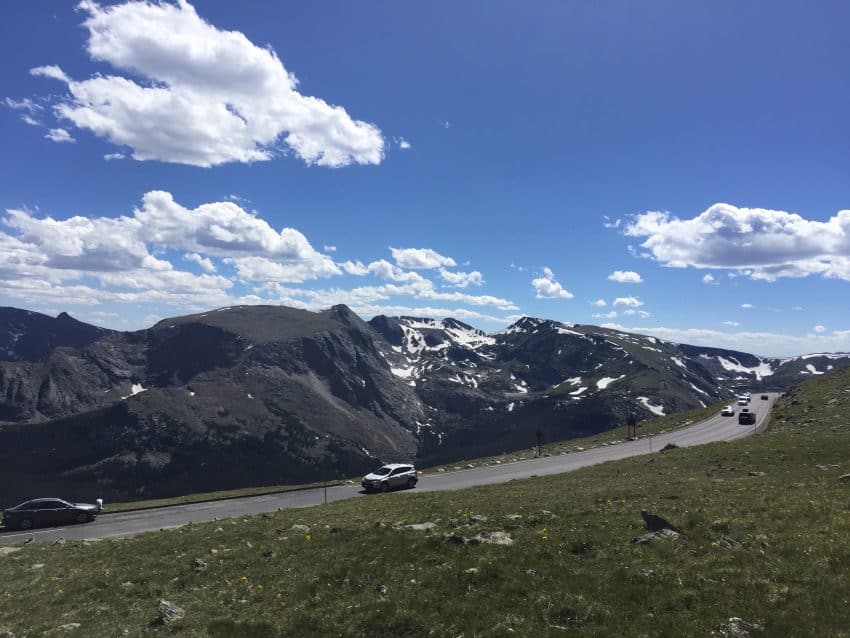
Experience the Rocky’s and the Comforts of Home
By Deb Schaffer
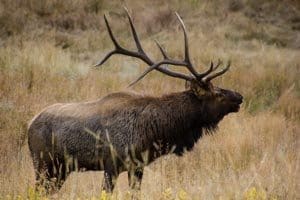
For those whose idea of camping is a luxury hotel, Rocky Mountain National Park is intimidating. The park is over 400 square miles of wild animals, aspen glades, and mountains spiraling into the sky.
There’s no excuse not to visit and hear the jays calling, the snow crunching, and the elk bugling. Some of us like to enjoy the outdoors – we just don’t want to walk for hours and then eat cold food and sleep on the ground.
Here are at least four things to do in Rocky Mountain National Park if you don’t like the idea of waking up without a coffee maker.
Spectacular Drives
Rocky Mountain National Park is the original “car friendly” national park. Unlike Yosemite, Grand Canyon, and Glacier National Parks, Rocky Mountain National Park was never served by the railroad. After the park was designated in 1915 by Woodrow Wilson, lodge owners and outfitters built roads, trails and areas to accommodate visitors.
After World War I, visitors to the park began to strain the meager facilities. During the Great Depression, the Civilian Conservation Corp built welcome facilities and completed Trail Ridge Road.
Trail Ridge Road is 48 miles of mountain vistas, glaciers, and stomach-clenching twists and turns. It’s the only road between the East and West entrances to the park. Back in the 1930’s, the Old Fall River Road connected both sides of the park. This road is difficult to traverse, and today it’s one way westbound and only open during the high summer months.
For those of us who love the mountains but prefer to climb them in a car, Trail Ridge Road affords incredible views and plenty of photo opportunities. Visitors begin the drive in forests of aspen and ponderosa pine, and quickly transition to subalpine forests of fir and spruce. Finally, the wind-twisted trees give way to the alpine tundra of tiny plants and chattering pikas.
At 12,000 feet above sea level, the Alpine Visitor’s Center is complete with snacks and gift shop. Walk the short half-mile path to the top of the Alpine Ridge Trail or the Tundra Communities Trail for even better views.
While not quite as spectacular as Trail Ridge Road, Bear Lake Road has plenty to recommend it. The road winds by Moraine Park, the site of the Stead Ranch, a visitor lodge that was razed in 1963. Today, that valley is a prime location to view the elk during the fall rut.
For fewer crowds, follow the Bear Lake Road and stop at the Hollowell Park Trailhead for great views of the surrounding mountains and meadows. In October, view the aspen trees lighting up the mountain side as the leaves turn to bright gold. There are a few trails here you can walk, with rest room facilities available.
Great Walks

If your idea of camping is a luxury hotel, hiking is probably not something you do often. On the east side of the park, stop in at the Beaver Meadows Visitors Center, just outside of Estes Park. This building is a National Historical Landmark, the highest historical designation a building can receive. In this beautiful building, grab a map of the trails available in the park.
Because of the number of visitors in high season, shuttles run between the most popular trailheads on the east side of the park. There’s a Park and Ride near the Glacier Basin Campground that’s perfect if you prefer to leave the driving to the professionals.
The nice bus drivers drop you off and return to the trailheads periodically throughout the day, about every 30 minutes starting at 7 a.m. The Sprague Lake Trail is a good choice because it’s only about a ½ mile roundtrip. The trail is packed gravel and visitors stroll around the ice-blue Sprague Lake.
The Moraine Park Discovery Center has a short nature trail that twists through the side of the mountain. There’s a booklet that provides information, describing the wildflowers, trees, and animals found along the trail. For those who prefer to amble instead of hike, this trail is a good choice.
Interested in spending a few hours actually hiking? The Pool Trail off the Fern Lake Trailhead is 3.4 miles, roundtrip. There is a bit of elevation change at 245 ft., though that’s not much if you’re reasonably fit and acclimatized to the altitude. The trail winds through a shaded valley along a rushing creek. Keep an eye out for deer and elk.
Ranger-led Programs
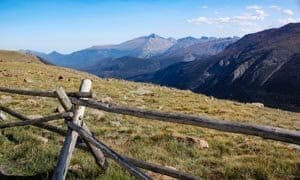
For folks who prefer their outdoors experience with a knowledgeable guide, the park offers many Ranger-led programs on both sides of the park. Depending on when you visit, there are talks at the Fall River Visitor Center on how artists have painted, drawn, and photographed the park over the years. The Moraine Park Discovery Center has a talk on the history of the park and its people.
The Beaver Meadows Visitor Center hosts a talk on bears and other wildlife in the park. The Rangers also lead walks and hikes, if you’re feeling particularly adventurous. Check the monthly park newspaper for the themes, dates and times. This season, there was a three hour hike called the Hike through History. It started at the Colorado River Trailhead on the west side of the park and explored the traces of mining and dude ranch history left in the area.
Wildlife Watching
Watching wildlife is one of the main pastimes for visitors. The best way to watch the wildlife is to stop, park off the road, turn off the car and just stay quiet. Depending on the season, visitors see elk, mule deer, moose and bighorn sheep.
In October and November, the elk come down from the high country and herd up in the meadows of Moraine Park and West Horseshoe Park. The bull elk bugle, trying to attract as many females, or cows, as possible. At the same time, the bull is warning all the other bulls away. Visitors can get surprisingly close to the display. Watch the bull elk harass his harem to keep them from wandering, at the same time he’s eyeing up a bull that wants to steal some of his cows. Occasionally two bulls start fighting, with their huge antlers crashing and clacking against each other.

Eventually, one gives up and is chased off. The victor can only hope the cows stayed around and a third bull didn’t run off with them. It can be quite a scene, with hundreds of animals within view.
Moose can be spotted during summer, mostly in the Kawuneeche Valley. They like the willow thickets near lakes. In the middle of the day in the summer, they often stand in ponds or lie in the shade to keep cool. Moose can move very fast, so stay in or near your car while watching them.
Mule deer can be seen at any time in the park, often in the lower valleys. There are also many different bird species that are at home here. Most visitors see and hear the Stellar’s jays, particularly if you’re picnicking. Those picnics also attract ground squirrels and other small furry creatures.
Bighorn sheep can be seen near Sheep Lakes on the east side during the summer. They can also be viewed through the winter along Fall River Road. They often look a bit raggedy, particularly when they shed their winter coats in the spring. They can be hard to spot, so stay still and wait.

Enjoy the Mountains
Rocky Mountain National Park can please anyone’s taste for the outdoors. For those who really don’t want to dramatically change elevations on foot or sleep on the ground, there are plenty of activities.
Since there are no lodging facilities in the park, guests stay outside the park in Estes Park, Grand Lake or Granby. There visitors can find hotel rooms to suit any budget and well as restaurants, bars, and diners.
On a visit to Rocky Mountain National Park, there’s no need to eat cold food, cook over an open fire, or sleep on the ground. And for that, many of us are very grateful.
If You Go…
Rocky Mountain National Park is in north-central Colorado, about a 1 ½ hour drive from the Denver area. The park is open every day of the year, 24 hours a day. Visitor center hours vary by season as do ranger-led programs.
Trail Ridge Road is closed from mid-October to the end of May. If you have any doubts as to whether the road is open, call the park at 970-586-1222.
Summer is the busiest time in the park, so be prepared for crowds at the most popular sites during the day. Pets are only allowed in parking lots, campgrounds, and along roadsides. Pets are not allowed on park trails, tundra, and meadow areas. Park entrance fees: $20 per car for a one day pass, $30 for a 7-day pass, and an annual pass is $50. Visit NPS.gov for more information.
You can also stay up-to-date on activities at the park through Facebook: facebook.com/RockyNPS and Twitter: @RockyNPS. Don’t miss the park’s Instagram account: @RockyNPS #RMNP.
 Deb Schaffer is an avid traveler, writer, and golfer. When not setting up a tee time or photographing Colorado, she’s planning the next trip or blogging. She’s just published her first book on Amazon, “Play golf, Colorado!” and is working on the second edition.
Deb Schaffer is an avid traveler, writer, and golfer. When not setting up a tee time or photographing Colorado, she’s planning the next trip or blogging. She’s just published her first book on Amazon, “Play golf, Colorado!” and is working on the second edition.
- These 9 U.S. National Parks Require Reservations in 2024 - April 17, 2024
- Take a Hike in Olympic National Park - April 17, 2024
- The Wild Mississippi: 2340 Miles Across Ten States - April 8, 2024


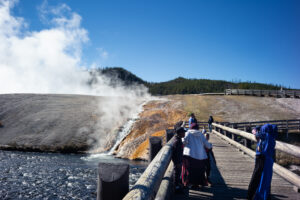


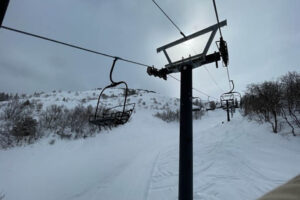
I don’t care for camping in altitude and cold. Nice story
Thanks! I hope you have the opportunity to enjoy the park someday. ~deb
I have always felt scared from rocky mountains but the things you listed out here to do are incredible specially when we hate camping. Such a wonderful article and i really like your ideas.